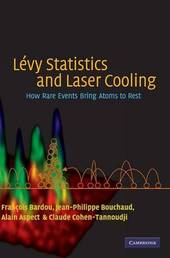
|
Levy Statistics and Laser Cooling: How Rare Events Bring Atoms to Rest
Hardback
Main Details
| Title |
Levy Statistics and Laser Cooling: How Rare Events Bring Atoms to Rest
|
| Authors and Contributors |
By (author) Francois Bardou
|
|
By (author) Jean-Philippe Bouchaud
|
|
By (author) Alain Aspect
|
|
By (author) Claude Cohen-Tannoudji
|
| Physical Properties |
| Format:Hardback | | Pages:214 | | Dimensions(mm): Height 244,Width 170 |
|
| Category/Genre | Atomic and molecular physics |
|---|
| ISBN/Barcode |
9780521808217
|
| Classifications | Dewey:539.7 |
|---|
| Audience | | Professional & Vocational | |
|---|
| Illustrations |
2 Tables, unspecified; 41 Line drawings, unspecified
|
|
Publishing Details |
| Publisher |
Cambridge University Press
|
| Imprint |
Cambridge University Press
|
| Publication Date |
20 December 2001 |
| Publication Country |
United Kingdom
|
Description
Laser cooling of atoms provides an ideal case study for the application of Levy statistics in a privileged situation where the statistical model can be derived from first principles. This book demonstrates how the most efficient laser cooling techniques can be simply and quantitatively understood in terms of non-ergodic random processes dominated by a few rare events. Levy statistics are now recognised as the proper tool for analysing many different problems for which standard Gaussian statistics are inadequate. Laser cooling provides a simple example of how Levy statistics can yield analytic predictions that can be compared to other theoretical approaches and experimental results. The authors of this book are world leaders in the fields of laser cooling and light-atom interactions, and are renowned for their clear presentation. This book will therefore hold much interest for graduate students and researchers in the fields of atomic physics, quantum optics, and statistical physics.
Author Biography
Francois Bardou obtained his Ph.D. in 1995 at the Ecole Normale Superieure de Paris for his experimental and theoretical studies of laser cooling below the one photon recoil, and was the 1995 winner of the Aime Cotton prize (Atomic Physics prize of the French Physical Society). He now works at the Centre National de la Recherche Scientifique (CNRS) where he works on stochastic problems in quantum tunnelling. Jean-Philippe Bouchard is a Senior Expert at the Service de Physique de l'Etat Condense and at CEA-Saclay. In 1994 he founded his own company called Science and Finance, and continues to have diverse research interests which include statistical physics, granular matter and theoretical finance. He is in charge of various statistical physics and finance courses in the Grandes Ecoles, Paris, and is the co-author of Theory of Financial Risk (Cambridge, 2000). Alain Aspect is a Director of Research at CNRS and a Professor at the Ecole Polytechnique, Palaiseau. After completing a series of experiments in the early 1980s on the foundations of quantum mechanics, he joined Claude Cohen-Tannoudji at the Ecole Normale Superieure to work on laser cooling of atoms. He is now head of the Atom Optics group of Institut d'Optique at Orsay and is the co-author of Introduction to Lasers and Quantum Optics (Cambridge, in preparation). Claude Cohen-Tannoudji is Professor of Atomic and Molecular Physics at the College de France in Paris and was honoured with the Nobel Prize for Physics in 1997 for his work on the development of methods to cool and trap atoms with laser light. He is also the co-author of three other books: Quantum Mechanics (1992), Photons and Atoms: Introduction to Quantum Electrodynamics (1989), and Atom-Photon Interactions: Basic Processes and Applications (1998).
Reviews'... a beautifully concise yet complete introduction to the logic of this incredible technique ... students of physics and other scientists interested in laser cooling will find this book hard to beat for insight and conceptual clarity.' Mark Buchanan, New Scientist '... an excellent and readable account that will be of considerable use not only to people interested in laser cooling, but also to those wishing to see this important set of techniques make an impact in studies of ultracold matter ... a significant addition to the literature in both laser cooling and statistical physics. It is rare to have such a lucid and convincing account of a technique that will be new to most scientists. It will be greatly welcomed both by workers in the field of ultracold atom physics and by those who want to see an important theoretical apparatus used in practice.' Keith Burnett, Nature '... hard to beat for insight and conceptual clarity.' New Scientist
|